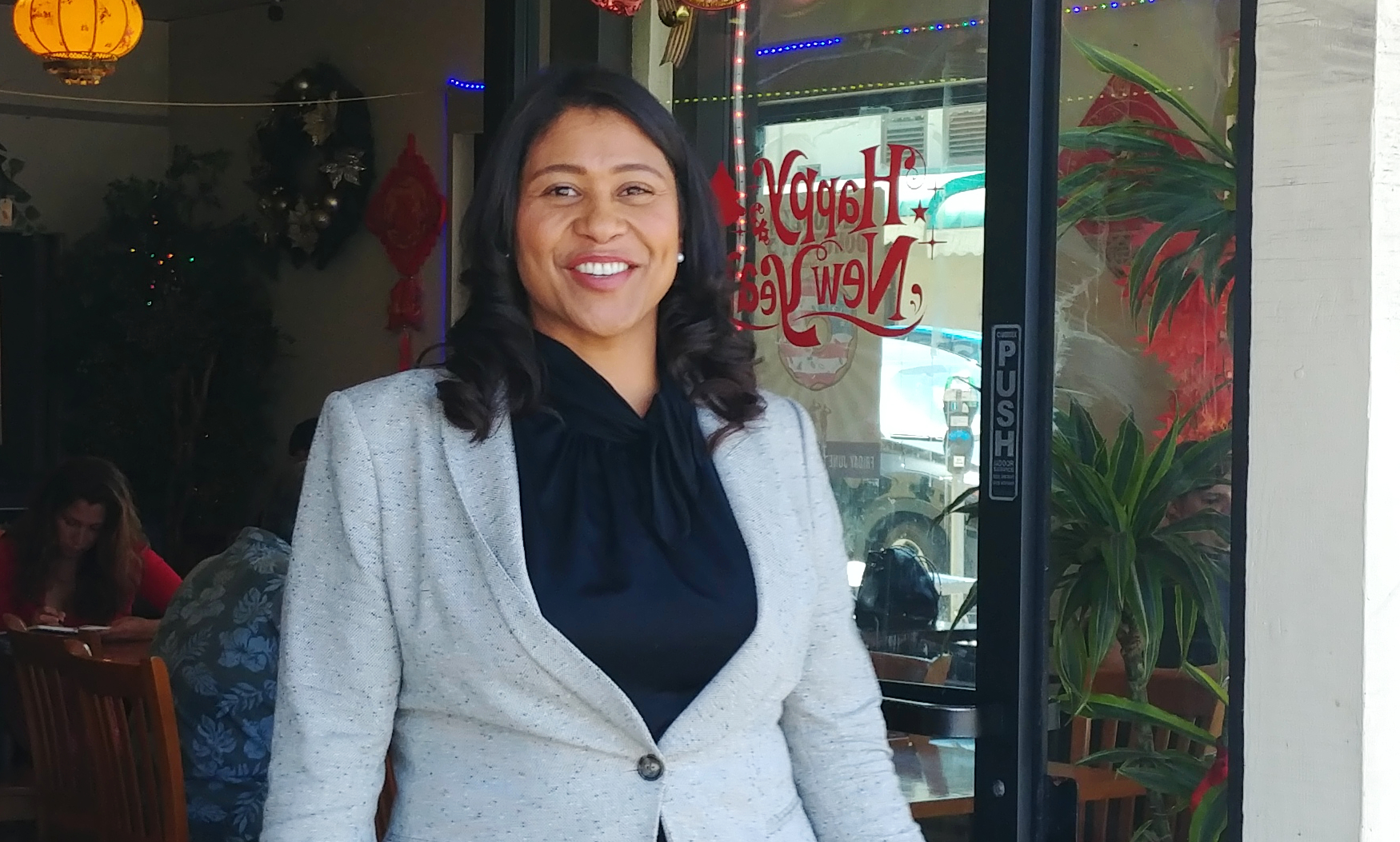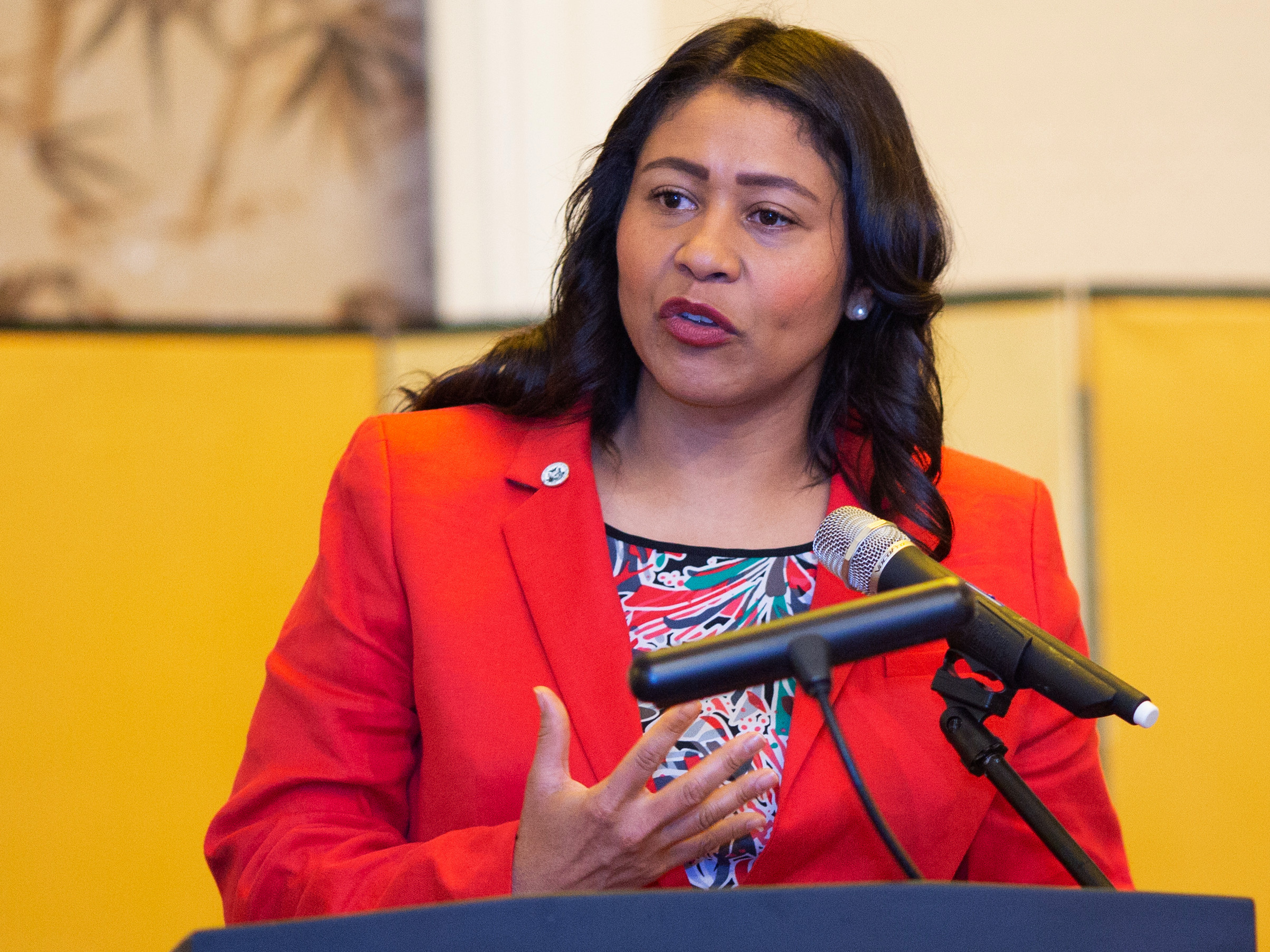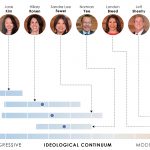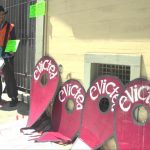London Breed has quickly ascended San Francisco’s political ladder. She was elected to the Board of Supervisors in 2012, became its president in 2015 and, after the abrupt death of Ed Lee in December, became acting mayor — briefly, thanks to her colleagues. She’s hoping voters Tuesday will give her an extended stay in Room 200 at City Hall.
She lists a bevy of accomplishments and proposals in the realms of housing and homelessness. In many cases she openly states that she did — or would, if elected mayor — play a support role to craft or implement city policy.
There are other policies where Breed’s ownership is undeniable.
In what would be a dramatic and controversial shift in City Hall’s homelessness policy, Breed proposes removing tent encampments citywide and relocating their occupants to a temporary, centralized site, with bathroom, showers, security and services, until they could be housed. The city’s director of homelessness has opposed such a “sanctioned encampment,” a term Breed avoids. Even with a regulated site, the city would still be on the hook to create more housing for these and other unsheltered residents, she told the Public Press in an interview. She proposes placing some of them in unoccupied buildings, vacant single-room occupancy hotels or possibly low-cost, prefabricated homes that she hopes will be manufactured in the city.
On a second high-profile policy — neighborhood preference for affordable housing — a Public Press examination of city data found an incremental increase in racial diversity in the affordable-housing population, though its impact on the African-American community appears slight so far. To help ease gentrification and the affordability crisis, Breed said she would also increase the supply of housing by rehabilitating or building out underutilized real estate.
Centralized Location for Homeless Encampments
Breed has criticized City Hall’s practice of disbanding clusters of tents and their homeless inhabitants, because the city lacks the permanent housing to offer every homeless person a slot. With its housing supply often saturated, the Department of Homelessness and Supportive Housing can offer only temporary shelter to most seeking homes. “Where are they going to go?” Breed asked.
If elected, she would take a different approach by moving all existing tent encampments to a single location, likely south of the Bay Bridge on land owned by the Port of San Francisco. She would simultaneously institute a zero-tolerance policy for encampments anywhere in the city. People who set up makeshift homes outside her new site would be quickly relocated to it. The site would have bathrooms and showers, and city staff would work with inhabitants to determine the social services and housing remedies best for them, in an effort to get them off the streets for good.
“My suggestion has everything to do with trying to centralize the encampments, for the purposes of getting us the time we need, and the resources in one location, to assist the people one at a time, rather than shifting them from one neighborhood to the next,” Breed said. She added that this would better enable street cleaning and prevent disease, which NBC Bay Area cataloged in an investigation.
Breed said she had not estimated the cost. She was open minded about expanding the model to receive other types of unsheltered residents, but tent dwellers would have priority.
There were 75 tent encampments in the city last year, Mission Local reported, though that number fluctuates. The Department of Homelessness and Supportive Housing often works with camp residents over many weeks, persuading them to depart for treatment programs, temporary housing or a bus ticket out of the city, the Public Press has reported. This process is called “resolution,” and occurs in response to complaints or when previously disbanded camps form again. This approach is different from “sweeps,” which the Department of Public Works frequently carry out in order to clean sidewalks, sometimes with little warning to encampment residents. The Chronicle reported this week that a “unified push by teams of street cleaners, police officers and counselors” has cleared 30 of the biggest camps in the past 18 months and that no gathering of more than 10 tents exists today.
Breed’s idea resembles what are called sanctioned encampments, variations of which exist in Portland, Seattle and, in recent months, Oakland. She rejected that label. In many instances such city-approved encampments have stood for several years, and she envisions that her site would shut down after about a year, presumably when all occupants’ needs were addressed.
“It takes time,” she said. “You can’t just wave a magic wand and it disappears.”
She added that she had floated her idea with Jeff Kositsky, director of the Department of Homelessness and Supportive Housing, but she declined to share his response. He told the Public Press last year that such encampments in Seattle and Portland “have all failed miserably” by reinforcing, instead of resolving, homelessness.
“Here’s the thing,” Breed said. “I’m not going to put any department heads in the middle of this campaign, for concern of putting them in an awkward position.”
Breed said that setting up the triage site would not be enough. The city would also have to build additional navigation centers — where people can typically stay for 60 days while receiving other services — and create more housing specifically for this population.
House Homeless in Vacant Buildings
Breed said she would experiment with housing formerly homeless people in unoccupied residential buildings. That might mean that the city helps an owner repair a building, if that were needed to make it habitable.
“It is really a lot less expensive to renovate than it will be to build new,” Breed said. She has yet to perform cost estimates, but she said the city might pay for this work with money from the General Fund, philanthropic contributions, federal tax credits or tax revenue from Proposition D, if it passes — Breed helped write the ballot measure, which is competing with another measure that would fund early child care and education. “We need to get creative about these solutions and use our existing resources in a more effective way.”
She said she was in contact with the owners of three such buildings, two of which are single-room occupancy hotels. Together, they contain about 70 units.
Mayoral candidate and former state Sen. Mark Leno has made a similar pitch, though his policy platform specifically targets SRO hotels. The Public Press revealed in October that 1,827 rooms in those hotels were being held empty for a variety of reasons, including lack of resources to bring the rooms up to building codes, wariness of taking on rent-controlled tenants and the desire to sell buildings for conversion to market-rate apartments or hotels.
Breed has also proposed housing homeless people in “modular” homes — prefabricated units built at a factory and stacked together on-site. She has said she plans to write and pass a general obligation bond for $50 million, which she estimates will pay for 600 modular homes. That assumes that San Francisco establishes its own modular-housing factory, which remains uncertain.
Breed’s intent is to get the private sector to “match or exceed” the bond amount, said Tara Moriarty, Breed’s press secretary. It is difficult to predict a per-unit construction cost, because that would vary among housing projects based on location and unit density. But she said Breed believes a cost of about $165,000 per modular unit “is a very reasonable, if not conservative, figure.” At that price, building 600 homes would cost $99 million. She added that cost predictions are challenging because the market is new.
Neighborhood Preference
In 2015, Breed co-sponsored so-called neighborhood preference legislation alongside Lee and supervisors Julie Christensen, Malia Cohen and Scott Wiener. (Supervisor Mark Farrell, now interim mayor, would later add his support.) The law set aside 40 percent of new affordable-housing units for applicants who lived within a half-mile of the property, or within the same supervisorial district.
Breed had been talking about enacting this type of policy since her 2012 supervisorial campaign, Moriarty said. As Breed fought for its passage, she branded the law a tool to help San Francisco hold on to its diminishing African-American population. More than 40,000 black residents have left San Francisco since 1970, when they were 13 percent of the population, census data show. By 2016, they constituted only about 6 percent. Breed represents District 5, which is one of the African-American community’s last enclaves. The district includes the Western Addition, Japantown and the Haight.
She went to the mat to get the neighborhood preference law enacted. On a trip to Washington, D.C., she persuaded the U.S. Department of Housing and Urban Development to accept a version of the policy for the Willie B. Kennedy senior housing complex, which was funded with HUD money. The department previously rejected giving preference to applicants living nearby, arguing that it violated the 1968 Fair Housing Act by limiting equal access.
The legislation has special significance for Breed who, while campaigning for mayor, has frequently invoked her identity as a black woman who grew up in the city’s public housing projects. She has called the law “groundbreaking” and a “monumental victory.”
How much has the law measurably helped African-Americans get into affordable housing? Data indicate that it has actually given little verifiable, direct help to black residents, though it may be increasing the racial diversity of the overall affordable-housing population.
By the end of 2017, applicants have been given neighborhood preference for 12 real estate projects, containing 271 units, according to December data that the Mayor’s Office of Housing and Community Development provided in response to a request from the Public Press. Two of those projects were composed entirely of affordable housing.
Only 27 of those units went to African-Americans.
Though the effect of the ordinance on its target demographic is small, that appears to represent an increase over the black occupancy rate prior to the law’s passage. In a subset of the affordable housing stock where neighborhood preference was not a factor — 181 buildings, containing 2,175 units for which demographic data were available — 85 units went to black tenants.
Those figures should be taken with caution, said Kate Hartley, director of the Mayor’s Office of Housing and Community Development. In the office’s portfolio of more than 19,000 affordable-housing units, “the older properties did not collect demographic information in any systematic way,” she said, and therefore could not be computed. That means the racial and ethnic makeup of the entire tenant population may look quite different from what this analysis showed. And while the office had accurate data for the newer buildings, where neighborhood preference applied, they constituted too small a sample size to necessarily forecast who will obtain affordable housing going forward.
The office’s analysis did not include African-Americans housed in the 98-unit Willie B. Kennedy complex, in the Western Addition, where Breed grew up. In December, 77 units at the property were occupied and 13 of the tenants were African-American, according to separate data from the office.
Potential Causes for Demographic Shift
It is unclear how much of the black occupancy rate can be attributed directly to neighborhood preference.
Hartley said that, in recent years, her office has tried to increase diversity among occupants by funding local organizations to do community outreach. Groups like the Mission Economic Development Agency engage with racial minority community groups that are underrepresented in affordable housing. “That makes a big difference, when you have someone doing community organizing and knocking on doors, and helping people fill out applications, and alerting people to opportunities,” she said.
Hartley also said that the affordable-housing application process has become more accessible since the city launched its unified and digitized lottery system in February 2016. Under the old system, people scoured multiple listings for available units and filled out new paper forms with each application. Applying through the new Database of Affordable Housing Listings, Information, and Applications — DAHLIA — takes minutes on a smartphone. It “has reached so many more people,” Hartley said.
“It is therefore possible that the increases you see in the total number of African-Americans and Latino households represented with the neighborhood preference is a function of time and access as much as the preference,” she said.
Whatever the reason, it appears that overall diversity increased.
Before neighborhood preference was adopted, Asians and Pacific Islanders occupied more units than any other demographic, about 43 percent. The next-biggest racial group was “unknown,” followed by Caucasians.
In the newer affordable housing, where neighborhood preference was a consideration, Asian and Pacific Islander occupancy dropped to about 37 percent, with all other demographics growing except for “unknown,” which shrank to 15 percent. African-Americans increased slightly more than did other demographics.
New Kinds of Construction
Breed became acting mayor on Dec. 12, 2017, following Lee’s death. Six weeks later, she announced plans for a modular-housing factory that would produce homes primarily for formerly homeless people, requiring less time and money than conventional construction.
That was Breed’s final move as acting mayor. Her office publicized it on the morning of Jan. 23. That night, the Board of Supervisors ousted her, naming Farrell interim mayor in her place.
Asked if San Francisco would have a modular-housing factory within the next decade, Hartley laughed. “My wish is yes. I just don’t know,” she said.
After months of reviewing applicants, the city is in negotiations over a contract with an expert consultant on modular housing, who will write a business plan for a factory after consulting city staff and trades representatives about how it could be built and operated. The budget for this position is about $70,000.
“They could say to us, ‘Here are the conditions that could create a feasible production facility, and they don’t exist,’” Hartley said. If that happened, the factory plan could die.
Local building-trades groups previously opposed a modular construction approach for new supportive-housing units, also intended to house the homeless, on formerly federal land at Mission and Seventh streets. The city gave the construction contract to Factory OS, a Vallejo-based company that uses carpenters to produce the modular housing. San Francisco Building and Construction Trades Council President Larry Mazzola objected that this would leave other craft unions out.
But Mazzola and the other unions agreed to support that project when Breed said local unions would be part of the planning process for San Francisco’s own modular-housing production facility.
5,000 Units Built Per Year?
San Francisco’s homelessness and housing-affordability crises are inextricably intertwined. Sixty-nine percent of the homeless people surveyed for the city’s 2017 point-in-time homelessness count said they had become homeless while living in San Francisco — almost identical to the percentage documented in the 2015 count. What was the leading reason for landing on the streets? Respondents cited the loss of a job, implying that they could no longer afford the cost of housing in one of the most expensive cities in the world.
“Supply and demand is real,” Breed proclaimed in her housing platform, “and we will see rents continue to climb if we don’t address it.”
She would try to keep the late Mayor Lee’s commitment of building 5,000 units per year. But that would be a major accomplishment. Over the past two decades San Francisco has hit that mark only once, in 2016, according to the city’s latest Housing Inventory.
One of her primary strategies would be to identify opportunities to add new housing by expanding and making more efficient use of preexisting structures. She named one example in her district: Freedom West, a housing cooperative with more than 300 units and spanning two blocks in the Western Addition.
First, Freedom West needs to be preserved, she said.
“The property’s falling apart,” she said. “And part of the requirement under the agreement between the co-op and HUD is maintaining it in a state of good repair, which has not occurred.” She speculated that, if nothing changes, HUD might foreclose on it and the city would almost certainly buy and rehabilitate it anyway to preserve the affordable housing.
But why stop at rehabilitating? The building has a large parking lot, and is shorter than the land’s height limits dictate. Breed would like to get community buy-in, and then grow the property.
“We could probably increase the capacity of this property three or even four times.”
The work could be funded by state or federal dollars, developer contributions, or money from the Mayor’s Office of Housing and Community Development, she said. If Proposition D passes, the tax revenue it generates might also go toward this work.
Breed said she has identified multiple properties in her district that could be preserved or further built out, but that she had not identified similar properties elsewhere in the city.
She surmises this approach could be scaled up to great effect: “If you’re talking about citywide, we’re talking about thousands” of units.
Breed admitted that “the city can’t afford to purchase all these properties,” so it would likely have to partner with private parties.
She made other proposals, including cutting back on “the bureaucratic red tape” in the development process by getting city departments to coordinate with each other earlier on. She is also open to the idea of increasing height or density limits on the city’s west side, which is far less developed than the east.
No one idea, on its own, would get San Francisco out of its homelessness and housing crises, she said.
“Part of the way we’re going to deal with these challenges — it’s everything. It’s the ADUs,” she said, referring to the construction of accessory-dwelling units on residential properties. “It’s modular housing, it’s building more, it’s identifying underutilized sites. It’s like, how we do all of these things together to produce more?”

Listen: KALW's Rose Aguilar interviewed London Breed on Your Call.











